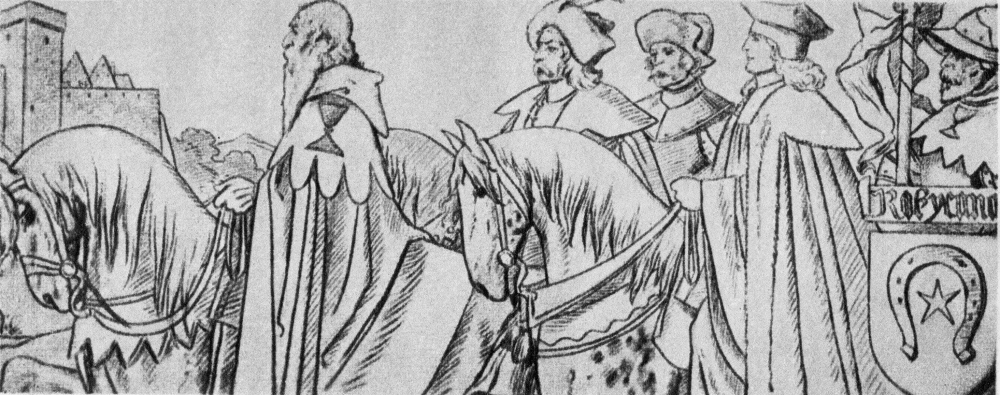Table of contents Show
The Hussite Wars were a string of theological and political battles that erupted in the fifteenth century and spread out from the Kingdom of Bohemia (now in the Czech Republic). Jan Hus’s preaching and the greater yearning for religious reform stoked the fires of these battles. The Hussite Wars were pivotal in shaping not only Bohemian history but also the Catholic Church and the evolution of religious thinking across Europe.
The theological reform ideals of Jan Hus are considered to be the root cause of Hussite wars. Hus’s condemnation of the corrupt nature of the Catholic Church and his appeals for reform were heard and supported by a sizeable percentage of the Bohemian populace. Hus’s death at the hands of the Council of Constance in 1415 sparked the subsequent wars.
Travelers interested in Czech history would do well to explore Newtown Prague while in the Czech capital. This is a historic location.
The Origins of Hussitism
The following events led to the birth of Hussitism. They include:
The execution of Jan Hus
A leading reformer and challenger of the Catholic Church, set off the conflicts in 1415. His killing provoked protests and cries for justice and change.
Hussite Beliefs
Jan Hus’s followers, known as Hussites, were strongly motivated by their faith in Jan Hus’s writings. They pushed for the widespread distribution of Bibles in the the local language, an end to ecclesiastical corruption, and the institution of communion under both sorts (food and wine) for the laity.
Religious and Political Conflict
Wars broke out between the Catholic Church and the Holy Roman Empire because their religious interests and those of the Hussites diverged.
The Beliefs and Principles of the Hussite religion
Hussite religion and values distinguished it from orthodox Catholicism and shaped European beliefs . Key Hussite ideas and principles:
Biblical Authority
As Jan Hus, the Hussites revered the Bible as the final authority of religious truths. They opposed the Roman Catholic Church’s stranglehold on scriptural interpretation by making the Bible available to all believers in their native language.
Communion Under Both kinds
Hussitism’s core principle was “Utraquism” . The Hussites believed the laity should receive Eucharistic bread and wine. It represented a closer relationship between those who believed and God.
Avoid Indulgences
Jan Hus taught Hussites to shun indulgences. They felt that faith, repentance, and a real relationship with God were sufficient for salvation, not Church indulgences.
Simplicity in Worship
The Hussite belief was easier to understand and more approachable than the Roman Catholic Church’s intricate procedures. Services were held in the native language rather than Latin to make them more accessible to the laity.
Moral Integrity
The Hussites, like Jan Hus, want better clerical morality and piety. They denounced Catholic Church corruption and hypocrisy and sought a more spiritually centered and honorable clergy.
Resistance to Papal Authority
The Hussites opposed the Pope’s supremacy and the Church’s hierarchy of power. They wanted more autonomy for the Bohemian Church and opposed Roman Catholic centralization.
National Identity
Hussitism helped Czechs feel proud of their nation. It symbolized Bohemian opposition to outside influences, notably the Catholic Church.
Hussite Factions
The Hussite movement had many factions with different views and practices. The Utraquists advocated moderate religious and changes in politics, while the Taborites were more extreme and promoted communal life and property redistribution.
The Outbreak of the Hussite Wars
There are several distinct periods during the Hussite Wars.
The First Crusade
The Hussite soldiers, headed by people like Jan ika and Prokop the Great, faced off against the fighting armies dispatched by the Catholic Church during the First Crusade (1419–1424). Two major groups with distinctive theological and political orientations, the Taborites and the Utraquists, gained prominence.
The Compact of Prague
In 1436, the warring parties signed the Compact of Prague, an agreement that established a temporary ceasefire and ended the worst of the fighting by granting significant concessions to the Utraquists. Freedom of religion and official acceptance of the Utraquist method of communion were both achieved.
Subsequent Conflicts
Tensions resurfaced despite the compact, and Hussite factions fought among themselves (1434–1437). There was increased instability as several groups struggled for control.
End of Open Warfare: The Hussite Wars officially ended in 1437, but religious and political conflicts remained high for decades afterwards.
H3: The Hussite War Wagons
A groundbreaking military innovation, the Hussite War Wagons (or Hussite Wagenburg, or Bojový Wagenburg in Czech) were used by Hussite armies during the Hussite Wars of the 15th century. At a time when the Hussites were fighting against the Holy Roman Empire and the Catholic Church, these war carriages were an essential part of their arsenal.
Hussite War Wagons used these components in their design:
Defensive Structure: Hussite War Wagons were effectively rolling fortifications, so they could defend themselves. They were built with defense in mind so that the occupants would be safe from attack.
Wooden Fortifications:The wagons’ frames made of wood and walls served as sturdy fortifications. The massive wooden planks used to support the sides of the wagons made them extremely safe from arrows, spears, and other projectile attacks.
Tactics:To defend themselves in battle, the wagons were arrayed in a circle, forming a “Wagenburg.” Hussite men could hide from the enemy’s fire inside the wagons and continue to use their rifles and artillery in this position.
Armament: Early firearms such as hand cannons and arquebuses were among the weapons mounted on the war wagons. The Hussites’ defenses were bolstered by their artillery, allowing them to better withstand assaults.
Mobility: Since the carts had wheels, they could be moved around the battlefield with ease. The Hussites could move the wagons to a new location if the situation demanded it.
The Legacy of the Hussite Wars
Religious Reform
The Hussite Wars were a sort of religious reform that occurred before the Protestant Reformation and is sometimes cited as a precursor to that movement. Protestant values such as laity involvement in the Eucharist and the adoption of the vernacular can be traced back to early Christian traditions.
Bohemian Identity
Wartime events contributed to the development of a strong sense of national pride and a unique Bohemian identity. When it came to protecting their faith and way of life, the Hussites considered themselves as protectors.
Impact on Europe
As a result of the Hussite Wars, the debate in Europe over church reform and lay participation in religious rituals was broadened beyond Bohemia.
Enduring ReligiousTraditions
Utraquist Church, founded during the Hussite Wars, survived for centuries and became an integral element of Czech religious life and Prague’s rich culture.





